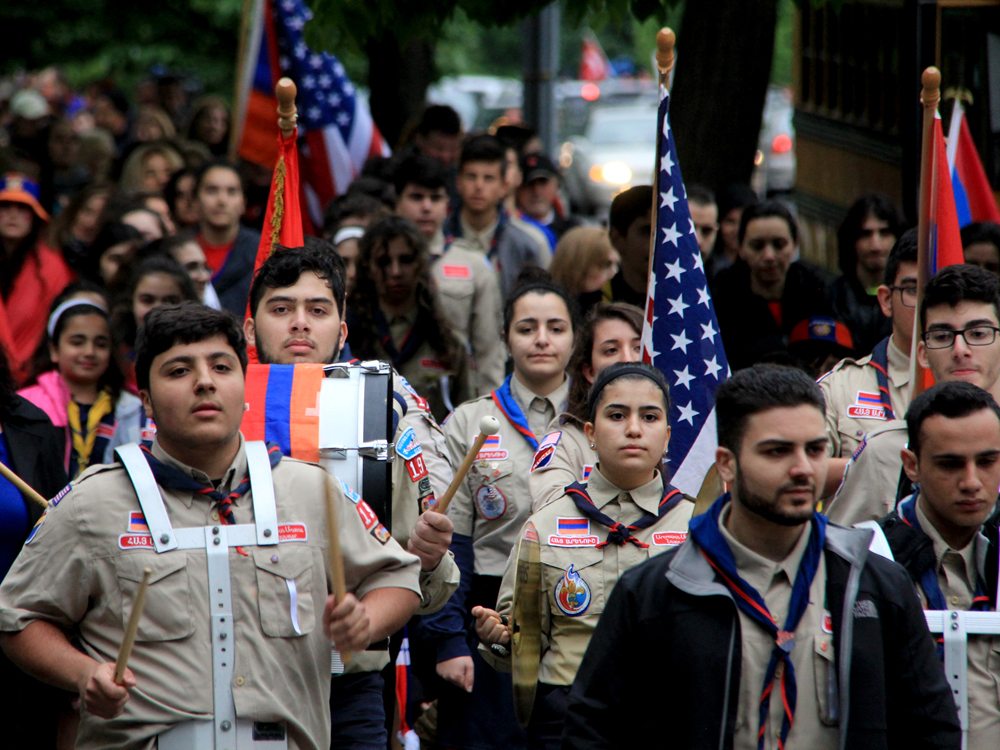There has always been speculation among us Diasporan Armenians about what it means to truly “be” Armenian. Is it the mastery of the language? The involvement in every aspect of the community, or a specific prominent facet of it? Or is it simply your name, first or last? Though there is no defined or tangible answer to what being an Armenian truly is, there is a deciding factor that helps one understand, for themselves, whether they identify as part of the rich culture: a feeling.

Armenian Americans march to the Embassy of the Republic of Armenia in April 2017, led by the Greater Washington D.C. Homenetmen Scouts and Drum Corps. (Photo: Armenian Genocide Commemorative Committee of Greater Washington)
But is it possible to “feel” Armenian all the time if you don’t live in a household where the language is spoken, or the cuisine is prepared? Is it possible to even be Armenian if you are somewhere where you can’t attend an Armenian Youth Federation (AYF) meeting, frequent your church, or spend time with other Armenians?
And, most important, if you were once integrated into a community where the Armenian culture was alive and well, and then had to leave that community, is it possible to get back in touch with that feeling of being Armenian?
For someone like me, with a distinctly Armenian name and parents who taught me to speak, read, and write Armenian, it was relatively easy feeling Armenian throughout my childhood. The real challenge presented itself when it was time for me to be on my own, without the influence of family and church. When I moved away from home to attend college, it seemed to me that the precious feeling of Armenianness was slipping away, fading as other things took its place.
There is no data to back up this claim that “being” Armenian can change based on your environment and feelings, but it is undeniable. After all, based on human experience, we know that environment has an impact on self-identity.
I have tried to home in the feeling I have been missing. I have spent long periods of time surrounded by Armenians, and I have worked for the Armenian Cause by interning with the Armenian National Committee of America (ANCA). I meet up with my Armenian friends as often as I can and reminisce about long, hot summers at AYF Camp Haiastan or exciting events from AYF Senior Olympics. Yet, when I am back home in my apartment, away from everything that sparks memories or ignites passion, it can be hard to feel immersed in something you are at that moment separated from.
So how does one preserve a feeling with limited firsthand resources? It all boils down to personal will: The feeling of being Armenian can be salvaged through effort and personal determination.
I feel much more Armenian at home with my family than far away on my own. Yet, I have a conscious awareness that I want to feel Armenian, and am proactive in doing so. I teach my friends about the Armenian culture. I frequent Armenian bakeries for tastes of home. But, most important, I don’t forget where I came from: I remind others of the Armenian culture and I continue to educate myself about it. I do all I can, and in my own way, to better further the Armenian Cause.
When you are out of touch with a community saturated with Armenians, it can be hard to preserve that part of your self-identity. But it is not impossible. There are things that can be done, tailored to each individual, that make the feeling of being Armenian come alive within.
I live my life as a product of the Armenian Diaspora in small ways, but they add up. When I truly feel Armenian, I feel complete. And it is important to me to do as much as I can to preserve that feeling no matter where I go.
The post The Transitions of Life and Their Impact on Cultural Identity appeared first on The Armenian Weekly.
Source: Armenian Weekly
Link: The Transitions of Life and Their Impact on Cultural Identity
